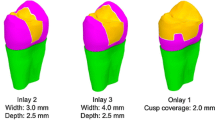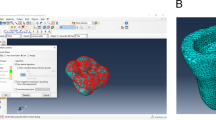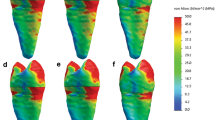Abstract
Objective
The aim of this study was to develop a new method for creating a multi-component and true scale 3-dimensional (3D) model of a human tooth based on cone-beam computed tomography (CBCT) images.
Materials and methods
First maxillary premolar tooth model was reconstructed from a patient’s CBCT images. The 2D serial sections were used to create the 3D model. This model was used for finite element analysis (FEA). Model validation was performed by comparing the ultimate compressive force (UF) obtained experimentally using a universal testing machine and from simulation. The simulations of three component-omitting models (silicone, cementum, and omitting both) were performed to analyze the maximum (max.) principal stress and stress distribution.
Results
The simulation-based UF indicating tooth fracture was 637 N, while the average UF in the in vitro loading was 651 N. The discrepancy between the simulation-based UF and the experimental UF was 2.2%. From the simulation, the silicone-omitting models showed a significant change in max. principal stress, resulting in a UF error of 26%, whereas there was no notable change in the cementum-omitting model.
Conclusion
This study, for the first time, developed a true scale multi-component 3D model from CBCT for predicting stress distribution in a human tooth.
Clinical relevance
This study proposed a method to create 3D modeling from CBCT in a true scale and multi-component manner. The PDL-like component-omitting simulation led to a higher error value of UF, indicating the importance of multi-component tooth modeling in FEA. Tooth 3D modeling could help determine mechanical failure in dental treatments in a more precise manner.









Similar content being viewed by others
References
Manokawinchoke J, Limjeerajarus N, Limjeerajarus C, Sastravaha P, Everts V, Pavasant P (2015) Mechanical force-induced TGFB1 increases expression of SOST/POSTN by hPDL cells. J Dent Res 94:983–989. https://doi.org/10.1177/0022034515581372
Manokawinchoke J, Sumrejkanchanakij P, Pavasant P, Osathanon T (2017) Notch signaling participates in TGF-β-induced SOST expression under intermittent compressive stress. J Cell Physiol 232:2221–2230. https://doi.org/10.1002/jcp.25740
Ramazanzadeh BA, Sahhafian AA, Mohtasham N, Hassanzadeh N, Jahanbin A, Shakeri MT (2009) Histological changes in human dental pulp following application of intrusive and extrusive orthodontic forces. J Oral Sci 51:109–115. https://doi.org/10.2334/josnusd.51.109
Soares CJ, Santana FR, Castro CG, Santos-Filho PCF, Soares PV, Qian F, Armstrong SR (2008) Finite element analysis and bond strength of a glass post to intraradicular dentin: comparison between microtensile and push-out tests. Dent Mater 24:1405–1411. https://doi.org/10.1016/j.dental.2008.03.004
Soares C, Versluis A, Valdivia A, Bicalho A, Verossimo C, Barreto BCF, Roscoe M (2012) Finite element analysis in dentistry; improving the quality of oral health care. https://doi.org/10.5772/37353
Soares PV, Souza LV, Veríssimo C, Zeola LF, Pereira AG, Santos-Filho PCF, Fernandes-Neto AJ (2014) Effect of root morphology on biomechanical behaviour of premolars associated with abfraction lesions and different loading types. J Oral Rehabil 41:108–114. https://doi.org/10.1111/joor.12113
Benazzi S, Grosse IR, Gruppioni G, Weber GW, Kullmer O (2014) Comparison of occlusal loading conditions in a lower second premolar using three-dimensional finite element analysis. Clin Oral Investig 18:369–375. https://doi.org/10.1007/s00784-013-0973-8
McCormack SW, Witzel U, Watson PJ, Fagan MJ, Groning F (2014) The biomechanical function of periodontal ligament fibres in orthodontic tooth movement. PLoS One 9:e102387. https://doi.org/10.1371/journal.pone.0102387
Dejak B, Młotkowski A (2015) A comparison of stresses in molar teeth restored with inlays and direct restorations, including polymerization shrinkage of composite resin and tooth loading during mastication. Dent Mater 31:e77–e87. https://doi.org/10.1016/j.dental.2014.11.016
Benazzi S, Nguyen HN, Kullmer O, Kupczik K (2016) Dynamic modelling of tooth deformation using occlusal kinematics and finite element analysis. PLoS One 11:e0152663. https://doi.org/10.1371/journal.pone.0152663
Barreto BCF, Van Ende A, Lise DP, Noritomi PY, Jaecques S, Sloten JV, De Munck J, Van Meerbeek B (2016) Short fibre-reinforced composite for extensive direct restorations: a laboratory and computational assessment. Clin Oral Investig 20:959–966. https://doi.org/10.1007/s00784-015-1576-3
Chieruzzi M, Pagano S, Cianetti S, Lombardo G, Kenny JM, Torre L (2017) Effect of fibre posts, bone losses and fibre content on the biomechanical behaviour of endodontically treated teeth: 3D-finite element analysis. Mater Sci Eng C 74:334–346. https://doi.org/10.1016/j.msec.2016.12.022
Lee HE, Lin CL, Wang CH, Cheng CH, Chang CH (2002) Stresses at the cervical lesion of maxillary premolar—a finite element investigation. J Dent 30:283–290. https://doi.org/10.1016/S0300-5712(02)00020-9
Guimarães JC, Guimarães Soella G, Brandão Durand L, Horn F, Narciso Baratieri L, Monteiro S Jr, Belli R (2014) Stress amplifications in dental non-carious cervical lesions. J Biomech 47:410–416. https://doi.org/10.1016/j.jbiomech.2013.11.012
Zeola L, Pereira F, Machado A, Reis B, Kaidonis J, Xie Z, Townsend G, Ranjitkar S, Soares P (2016) Effects of non-carious cervical lesion size, occlusal loading and restoration on biomechanical behaviour of premolar teeth. Aust Dent J 61:408–417. https://doi.org/10.1111/adj.12391
Correia AMO, Tribst JPM, Matos FS, Platt JA, Caneppele TMF, Borges ALS (2018) Polymerization shrinkage stresses in different restorative techniques for non-carious cervical lesions. J Dent 76:68–74. https://doi.org/10.1016/j.jdent.2018.06.010
Nikolaus A, Currey JD, Lindtner T, Fleck C, Zaslansky P (2017) Importance of the variable periodontal ligament geometry for whole tooth mechanical function: a validated numerical study. J Mech Behav Biomed Mater 67:61–73. https://doi.org/10.1016/j.jmbbm.2016.11.020
Gröning F, Bright JA, Fagan MJ, O'Higgins P (2012) Improving the validation of finite element models with quantitative full-field strain comparisons. J Biomech 45:1498–1506. https://doi.org/10.1016/j.jbiomech.2012.02.009
Cuddihy M, Gorman CM, Burke FM, Ray NJ, Kelliher D (2013) Endodontic access cavity simulation in ceramic dental crowns. Dent Mater 29:626–634. https://doi.org/10.1016/j.dental.2013.03.001
Jakupović S, Anić I, Ajanović M, Korać S, Konjhodžić A, Džanković A, Vuković A (2016) Biomechanics of cervical tooth region and noncarious cervical lesions of different morphology; three-dimensional finite element analysis. Eur J Dent 10:413–418. https://doi.org/10.4103/1305-7456.184166
Ruengdit S, Riengrojpitak S, Tiensuwan M and Santiwong P (2011) Sex determination from teeth size in Thais. Proceeding the 6th CIFS Academic Day 2011:1–12. http://www.forensic.sc.mahidol.ac.th/proceeding/52_Sittiporn.pdf, accessed on 30th May 2018
Özcan E, Çolak H, Hamidi MM (2012) Root and canal morphology of maxillary first premolars in a Turkish population. J Dent Sci 7:390–394. https://doi.org/10.1016/j.jds.2012.09.003
Mathew R, Katyal A, Shetty A, Krishna Nayak U (2016) Effect of increasing the vertical intrusive force to obtain torque control in lingual orthodontics: a three-dimensional finite element method study. Indian J Dent Res 27:163–167. https://doi.org/10.4103/0970-9290.183120
Miura J, Maeda Y, Nakai H, Zako M (2009) Multiscale analysis of stress distribution in teeth under applied forces. Dent Mater 25:67–73. https://doi.org/10.1016/j.dental.2008.04.015
Ho SP, Marshall SJ, Ryder MI, Marshall GW (2007) The tooth attachment mechanism defined by structure, chemical composition and mechanical properties of collagen fibers in the periodontium. Biomaterials 28:5238–5245. https://doi.org/10.1016/j.biomaterials.2007.08.031
Farah JW, Craig RG, Merough KA (1989) Finite element analysis of three- and four-unit bridges. J Oral Rehabil 16:603–611. https://doi.org/10.1111/j.1365-2842.1989.tb01384.x
Eisenburger M, Gray G and H. T (2000) Long-term results of telescopic crown retained dentures--a retrospective study. Eur J Prosthodont Restor Dent 8:87–91
Pepper T (2001) Polyester resins, ASM handbook volume 21, composites. ASM International
Composite Materials Handbook. SAE, (2012) vol2. SAE International
Khurukijwanich C, Aimmanee S, Kaikeerati N, Polmook K (2013) Analysis and design of electricity transmission pole composed of glass-fiber reinforced composite. https://doi.org/10.13140/RG.2.2.34633.65123
Thaipipe, Co. Ltd. Product catalogue manual, http://www.thaipipe.co.th/product-01-01-th.html, accessed on 27th May 2018
Stain Steel- Grade 304 (UNS S304400), (2001), https://www.lenntech.com/stainless-steel-304.htm, accessed on 9th Feb 2018
Holberg C, Rudzki-Janson I, Wichelhaus A, Winterhalder P (2013) Ceramic inlays: is the inlay thickness an important factor influencing the fracture risk? J Dent 41:628–635. https://doi.org/10.1016/j.jdent.2013.04.010
Liao S-H, Tong R-F, Dong J-X (2008) Influence of anisotropy on peri-implant stress and strain in complete mandible model from CT. Comput Med Imaging Graph 32:53–60. https://doi.org/10.1016/j.compmedimag.2007.09.001
Khasnis SA, Kidiyoor KH, Patil AB, Kenganal SB (2014) Vertical root fractures and their management. J Conserv Dent 17:103–110. https://doi.org/10.4103/0972-0707.128034
Štamfelj I, Vidmar G, Cvetko E, Gašperšič D (2008) Cementum thickness in multirooted human molars: a histometric study by light microscopy. Ann Anat 190:129–139. https://doi.org/10.1016/j.aanat.2007.10.006
Reimann S, Keilig L, Jäger A, Brosh T, Shpinko Y, Vardimon AD, Bourauel C (2009) Numerical and clinical study of the biomechanical behaviour of teeth under orthodontic loading using a headgear appliance. Med Eng Phys 31:539–546. https://doi.org/10.1016/j.medengphy.2008.08.008
Ahmed SS, Bhardwaj S, Ansari MK, Farooq O, Khan AA (2017) Role of 1.5 mm microplates in treatment of symphyseal fracture of mandible: a stress analysis based comparative study. J Oral Biol Craniofac Res 7:119–122. https://doi.org/10.1016/j.jobcr.2017.03.009
Ruse ND (2008) Propagation of erroneous data for the modulus of elasticity of periodontal ligament and gutta percha in FEM/FEA papers: a story of broken links. Dent Mater 24:1717–1719. https://doi.org/10.1016/j.dental.2008.04.006
O'Mahony AM, Williams JL, Spencer P (2001) Anisotropic elasticity of cortical and cancellous bone in the posterior mandible increases peri-implant stress and strain under oblique loading. Clin Oral Implants Res 12:648–657. https://doi.org/10.1034/j.1600-0501.2001.120614.x
Wang S, Xu Y, Shen Z, Wang L, Qiao F, Zhang X, Li M, Wu L (2017) The extent of the crack on artificial simulation models with CBCT and periapical radiography. PLoS One 12:e0169150. https://doi.org/10.1371/journal.pone.0169150
Acknowledgements
We thank Dr. Kevin Tompkins for critical review of the manuscript.
Funding
The work was supported by the Dental Research Fund (3200502–03/2016 and DRF61016) of the Faculty of Dentistry, Chulalongkorn University, and the Thailand Research Fund (TRG 5800218). The Center of Excellence for Regenerative Dentistry Project is supported by the Chulalongkorn Academic Advancement into its Second Century Project, the Ratchadapisek Sompoch Endowment Fund. We also acknowledge financial support funded by Thai-Nichi Institute of Technology (1804/A014).
Author information
Authors and Affiliations
Corresponding author
Ethics declarations
Conflict of interest
The authors declare that they have no conflict of interest.
Ethical approval
All procedures performed in studies involving human participants were in accordance with the ethical standards of Human Research Ethics Committee at the Faculty of Dentistry, Chulalongkorn University and with the 1964 Helsinki declaration and its later amendments or comparable ethical standards.
Informed consent
Informed consent was obtained from all individual participants included in the study.
Additional information
Publisher’s note
Springer Nature remains neutral with regard to jurisdictional claims in published maps and institutional affiliations.
Rights and permissions
About this article
Cite this article
Limjeerajarus, N., Dhammayannarangsi, P., Phanijjiva, A. et al. Comparison of ultimate force revealed by compression tests on extracted first premolars and FEA with a true scale 3D multi-component tooth model based on a CBCT dataset. Clin Oral Invest 24, 211–220 (2020). https://doi.org/10.1007/s00784-019-02919-8
Received:
Accepted:
Published:
Issue Date:
DOI: https://doi.org/10.1007/s00784-019-02919-8




